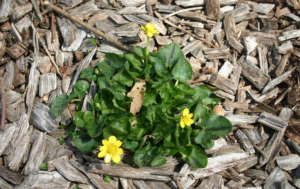Amur HoneysuckleAmur Honeysuckle is a noxious woody shrub, introduced in southern Ohio in the late 1950s but is now rampant across the state and throughout much of the Eastern United States. |
Callery PearCallery pear is an ornamental pear tree, introduced to North America in the early 1900s for agricultural use and quickly became a favorite in landscaping for its adaptability, flowering, fall color, and rounded crown. |
Winter CreeperWinter Creeper is a vine that invades forest openings and margins. It grows across the ground, displacing herbaceous plants and seedlings, and climbs trees high into the tree canopy by clinging to the bark. |
Lesser CelandineLesser Celandine is a herbaceous plant with a thick tuberous root, bright yellow springtime flowers, and dark green heart-shaped leaves. It is a highly invasive species that is very difficult to eradicate once it establishes at a site. |
English IvyEnglish Ivy is a vine that attaches to the bark of trees, brickwork, and other surfaces by root-like structures. It is an aggressive invader threatening all levels of forested and open areas, by blocking sunlight from the host tree’s foliage and impeding photosynthesis. |
Burning BushWinged Burning Bush can invade not only a variety of disturbed habitats including forest edges, old fields, and roadsides but also undisturbed forests. Birds and other wildlife eat and disperse the fruit. Once established, it can form dense thickets, displacing native vegetation. |
Porcelain-berryPorcelain-berry has become a serious invader of the eastern United States and closely resembles native species of grape. It is a deciduous, woody vine that climbs to heights of more than 20 ft. The thick mats formed by this climbing vine can cover and shade out native shrubs and young trees. |
Oriental BittersweetOriental Bittersweet is a deciduous, climbing, woody vine, commonly found in old home sites, fields, and road edges. The fast-growing vines can cover, shade and outcompete other vegetation. It can even girdle and kill large trees. Birds and other wildlife eat the fruit, thus distributing the seeds. |
Japanese Chaff FlowerJapenese Chaff Flower readily invades bottomland forests, wooded riverbanks, roadsides, ditches, and field edges since it prefers partial sun and moist soils and can survive in the shade and dry conditions. |
Tree-of-HeavenTree-of-Heaven is a highly invasive tree, brought to this country in the early 1800s as a source of food for silkworms. It is often found in urban areas and thrives in disturbed and neglected sites where polluted conditions and rocky soils prohibit anything but weeds from growing. |
Autumn OliveAutumn Olive is a large deciduous shrub covered with small silvery to rust colored scales. In its favored habitats, it out-competes native shrubs and herbaceous plants by forming dense thickets. Its high rate of seed production contributes to its spread and overall invasiveness. |












